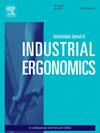上肢职业外骨骼研究综述:从技术到评估
IF 3
2区 工程技术
Q2 ENGINEERING, INDUSTRIAL
International Journal of Industrial Ergonomics
Pub Date : 2025-10-08
DOI:10.1016/j.ergon.2025.103815
引用次数: 0
摘要
职业外骨骼正在成为一个有前途的解决方案,以减少与工作有关的肌肉骨骼疾病(MSDs)在各个行业。考虑到与重复性手臂运动和头顶任务相关的msd的高患病率,上肢外骨骼尤其相关。然而,评估这些装置的有效性需要仔细分析它们所包含的具体技术和运动学设计,以确保其安全有效地集成。本文对现有文献进行了详细的技术回顾和分析,重点关注技术的多样性以及在实验室和现实世界环境中应对挑战的更全面研究的必要性。这项研究特别强调了对不同外骨骼技术的独特特征进行评估的必要性,而不是对它们进行概括。它还强调,不仅需要检查肌肉活动的减少,还需要检查潜在的被忽视的副作用、长期影响以及不同任务类型的适应性。这些因素是至关重要的,因为上肢外骨骼计划在复杂的工业环境中长期使用。本文章由计算机程序翻译,如有差异,请以英文原文为准。
Review of upper-limb occupational exoskeletons: From technology to assessment
Occupational exoskeletons are emerging as a promising solution to reduce work-related musculoskeletal disorders (MSDs) across various industries. Upper-limb exoskeletons are particularly relevant, given the high prevalence of MSDs associated with repetitive arm motions and overhead tasks. However, evaluating the effectiveness of these devices requires careful analysis of the specific technologies and kinematic designs they incorporate to ensure their safe and effective integration. This paper presents a detailed technological review and analysis of the existing literature, focusing on the diversity of technologies and the need for more comprehensive studies addressing challenges in both laboratory and real-world settings. This study particularly highlights the necessity of assessments that account for the unique characteristics of different exoskeleton technologies, rather than generalizing across them. It also emphasize the need to examine not only reductions in muscle activity but also the potential for overlooked side effects, long-term impacts, and adaptations across different task types. These factors are crucial, as upper-limb exoskeletons are planned to be deployed for prolonged use in complex industrial environments.
求助全文
通过发布文献求助,成功后即可免费获取论文全文。
去求助
来源期刊
CiteScore
6.40
自引率
12.90%
发文量
110
审稿时长
56 days
期刊介绍:
The journal publishes original contributions that add to our understanding of the role of humans in today systems and the interactions thereof with various system components. The journal typically covers the following areas: industrial and occupational ergonomics, design of systems, tools and equipment, human performance measurement and modeling, human productivity, humans in technologically complex systems, and safety. The focus of the articles includes basic theoretical advances, applications, case studies, new methodologies and procedures; and empirical studies.

 求助内容:
求助内容: 应助结果提醒方式:
应助结果提醒方式:


